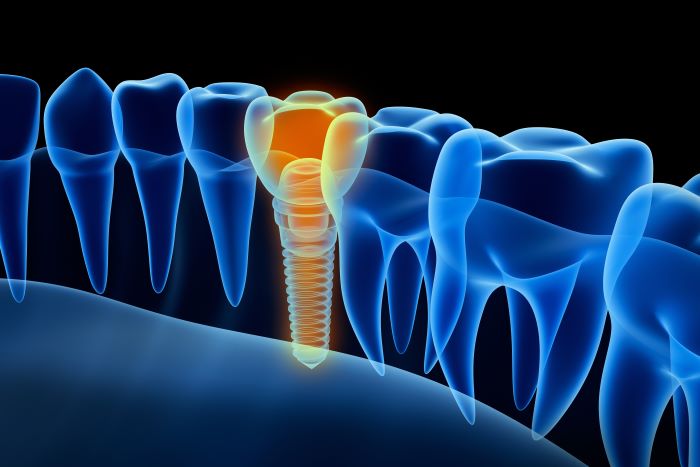Dental Implants & Dentures: Restore Your Natural Smile
When you lose your natural teeth, it can mean more than just a change in how you look. It changes how you talk, chew, and feel good about yourself, and over time, it can change the shape of your face. Even though tooth loss is common, especially in older adults or those with advanced periodontitis, it is a big clinical problem. The effects are much worse than just how things look if nothing is done. Patients may have to deal with problems like losing alveolar bone, their face changing shape, and their mouth not working right. Fortunately, modern restorative dentistry has very effective, evidence-based treatments like dental implants and dentures.
What Happens When You Lose Teeth
You need to know what happens when teeth are lost to understand how important it is to replace them. Every natural tooth has a job to do. It sends bite forces into the jawbone and keeps the tissues around it healthy. When a tooth is pulled or lost, the alveolar bone starts to break down because it isn't getting enough stimulation. The slow loss of bone can make the face collapse, move the remaining teeth, and make the mouth less healthy.
The lack of teeth also makes it hard to chew and speak. Chewing becomes less effective, some foods are harder to handle, and speech may be affected, especially when front teeth are lost. As professional dental literature and clinical teams like those at Fine Dentistry of Orlando have said, these changes can make you more likely to get periodontal disease and systemic inflammation if you don't do anything about them.
Choosing Between Two Tried-and-True Choices
There are two main ways to fix a full smile: with traditional dentures or with implants. Both methods can work very well if they are carefully matched to the person's body, health history, and goals.
People still like removable dentures, especially if they are missing more than one or all of their teeth in an arch. Dentures made today are more accurate and look better than ever. But they can't stop the bone from continuing to dissolve after a tooth is lost because they sit on top of the gums and aren't connected to the bone.
Dental implants, on the other hand, are fake tooth roots that are surgically put into the jawbone. When they are put together, they provide stable support for crowns, bridges, or even full-arch prostheses. This fixed support is more like real teeth than any other kind of support that can be taken out. Fine Dentistry of Orlando's clinical resources show that implants can make speech clearer, chewing easier, and the face look better. Osseointegration can also help keep the bone structure intact
The lack of teeth also makes it hard to chew and speak. Chewing becomes less effective, some foods are harder to handle, and speech may be affected, especially when front teeth are lost. As professional dental literature and clinical teams like those at Fine Dentistry of Orlando have said, these changes can make you more likely to get periodontal disease and systemic inflammation if you don't do anything about them.
The Materials and Methods That Go Into Each Method
From the perspective of materials science, implant components are typically fabricated from medical-grade titanium due to its biocompatibility and ability to integrate with osseous tissue. Some patients who are sensitive to certain materials or who care more about how they look may be able to use zirconia. People often use lithium disilicate or zirconia ceramics to make prosthetic crowns or bridges that are held up by implants. We chose these materials because they are strong, clear, and look like real teeth.
The first steps in the clinical process for putting in an implant are usually digital imaging and surgical planning. Fine Dentistry and other advanced practices use digital intraoral scanners and CBCT technology to make accurate diagnoses and plan treatments. A custom restoration is made and put in place after a healing time of three to six months.
High-impact acrylics and thermoplastics are the main materials used to make traditional dentures. These materials are carefully shaped to fit over the gums. Advanced digital denture design has made them fit better and look better, but they may not stay in place for long without support from the bone underneath. For a lot of patients, implant-retained dentures are the best of both worlds because they are removable and more stable.
Why Some Patients Choose Implants and Others Don't
The advantages of implant-based treatment are substantial. Unlike traditional dentures, implants help preserve bone density and facial structure over time. Many patients find comfort in the fact that they work better, chew better, and feel more permanent. When restored carefully, implant-supported teeth look and feel just like natural teeth.
That said, implants need a lot of bone and a healthy body to heal properly. Uncontrolled diabetes, smoking, or active periodontal disease are examples of conditions that could make outcomes worse. Also, implants have to be put in through surgery and take longer to heal than regular dentures.
Even though dentures don't hold bone very well, they might be the best option for people who want a quick and easy fix. They are still a good choice for people who have lost a lot of bone or have complicated medical histories because they can be changed to fit their needs. They can last for years if you clean and care for them.
Thinking Long-Term: Maintenance and Expectations
No matter what path a patient takes, long-term care is important. People who have implants need to keep the tissues around them healthy to avoid peri-implantitis, which is similar to periodontitis. This means that you should see the dentist often, get professional cleanings, and take good care of the areas around the implants at home.
People who wear dentures should also have their dentures checked every so often to make sure they fit and work right. Over time, changes in the amount of bone may mean that relines or adjustments are needed. Even if you have removable prosthetics, you should still go to the dentist regularly because dentures that don't fit right can make your mouth hurt, make it hard to talk, and make chewing less effective. In either case, how well you take care of your teeth, eat well, and get follow-up care will determine how well things go in the long run. As clinical studies have shown over and over again, patients who keep up with their dental care have much better functional and aesthetic outcomes, no matter what restorative technique they choose.
Fixing a Smile Means Making Your Life Better
When you lose teeth, it changes more than just how your smile looks. It changes how you eat, talk, and deal with other people. Modern restorative dentistry can do more than just fill in gaps; it can also restore health, function, and confidence.
Today's treatments are based on both art and science, whether it's the stability of implants or the flexibility of dentures. Not only do they improve appearance, but they also fix the structure of the mouth, giving patients back their smile and their quality of life.
To learn more about your options for replacing missing teeth with implants or dentures, call (407) 777–2071 to schedule a private consultation.

